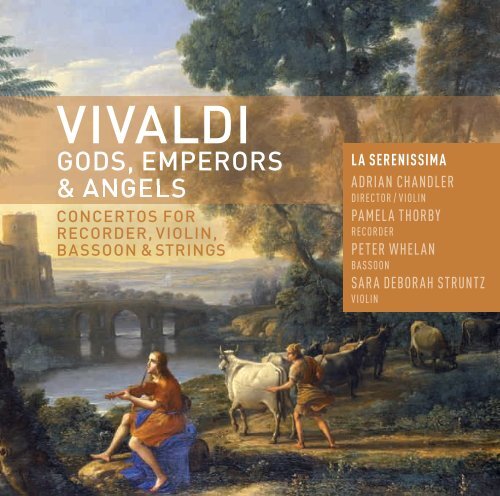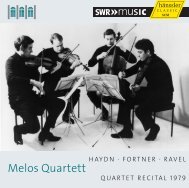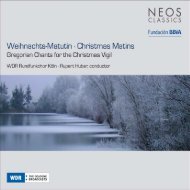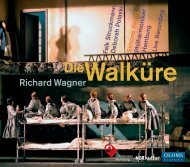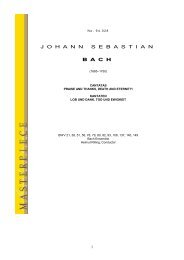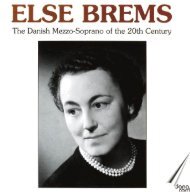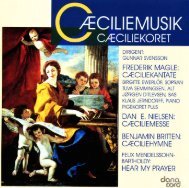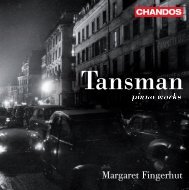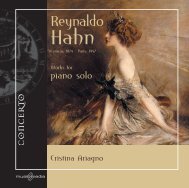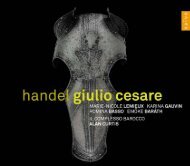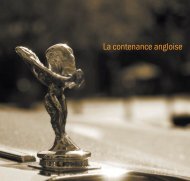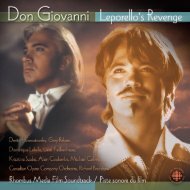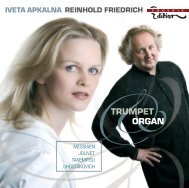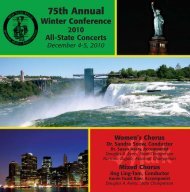ViVAldi - Naxos Music Library
ViVAldi - Naxos Music Library
ViVAldi - Naxos Music Library
Create successful ePaper yourself
Turn your PDF publications into a flip-book with our unique Google optimized e-Paper software.
<strong>ViVAldi</strong><br />
GodS, EMPERoRS<br />
& AnGElS<br />
ConCERtoS FoR<br />
RECoRdER, Violin,<br />
BASSoon & StRinGS<br />
L A SEREnISSIMA<br />
ADRIAN ChANDleR<br />
DIReC ToR / V IolIN<br />
PAMel A ThoRBY<br />
ReCoRDeR<br />
PeTeR Whel AN<br />
BASSooN<br />
SAR A DeBoR Ah STRUNTZ<br />
V IolIN
G o d s, Emperors & A n gel s<br />
C o ncertos for recorder, v i o l in & b a s s o o n<br />
Antonio Vivaldi (1678 – 1741)<br />
Concerto Conca for strings<br />
and continuo in B , RV 163 3:50<br />
1 Allegro – Allegro molto 1:50<br />
2 Andante 0:48<br />
3 Allegro 1:12<br />
Concerto IX from La cetra (Opus 9)<br />
for 2 violins, strings & continuo<br />
in B , RV 530 9:29<br />
4 Allegro 3:34<br />
5 Largo e spiccato 3:07<br />
6 Allegro 2:48<br />
Concerto for bassoon,<br />
strings & continuo in a minor, RV 500 9:52<br />
7 Allegro 3:26<br />
8 Largo 3:25<br />
9 Allegro 3:01<br />
Concerto for sopranino recorder,<br />
strings & continuo in a minor, RV 445 10:29<br />
10 Allegro 4:19<br />
11 Largo 2:53<br />
12 Allegro molto 3:17<br />
Concerto VI from La cetra (MS)<br />
for 2 violins, strings & continuo<br />
in B , RV 526 8:28<br />
reconstruction: Adrian Chandler<br />
13 Allegro 3:21<br />
14 Largo 2:13<br />
15 Allegro 2:54<br />
Sonata for recorder, bassoon &<br />
continuo in a minor, RV 86 8:42<br />
16 Largo 3:38<br />
17 Allegro 2:26<br />
18 Largo 2:38<br />
19 Allegro molto 2:01
Concerto fragment for bassoon,<br />
strings & continuo in d minor, RV 482<br />
20 Allegro molto 2:46<br />
Concerto fragment for sopranino<br />
recorder, strings & continuo in G,<br />
RV 312<br />
reconstruction: Adrian Chandler<br />
21 Allegro molto 3:39<br />
Concerto X L’Amoroso from<br />
La cetra (MS) for violin, strings &<br />
continuo in E, RV 271 11:45<br />
22 Allegro 4:35<br />
23 Largo/Cantabile 2:57<br />
24 Allegro (cadenza: Adrian Chandler) 4:13<br />
Pitch: A = 440 Hz<br />
Temperament: Vallotti<br />
Keyboard preparation:<br />
Malcolm Greenhalgh & James Johnstone<br />
Editions: Adrian Chandler<br />
Recorded: February 10 – 13 2010<br />
at the Hospital of St. Cross,<br />
Winchester, Hampshire, UK
La Serenissima<br />
Pamela Thorby · Recorder<br />
Sopranino recorder: Moeck, 2009,<br />
after Jean-Hyacinth-Joseph Rottenburgh (1672 – 1756)<br />
Alto recorder: Friedrich von Huene 1986,<br />
after Jean-Jacques Rippert (c1645 –1724)<br />
Peter Whelan · Bassoon<br />
Peter de Koningh, 2007, Holland,<br />
after anonymous Venetian model<br />
Adrian Chandler · Solo Violin & Director<br />
Rowland Ross, 1981, after Amati<br />
Sara Deborah Struntz · Solo Violin 2 & Violin 1<br />
Federico Lowenberger, Genova, 2008, after Maggini<br />
Simon Kodurand · Violin 1<br />
Christopher Rowe, 1993, Isle of Wight, after J Guarneri<br />
Leonie Curtin · Violin 1<br />
Anon., c1790, South Germany<br />
Sarah Moffatt · Violin 2<br />
Anon., Roman school, c1740<br />
Kathryn Parry · Violin 2<br />
Willibrord Crijnen, 1998, Marseille, after Stainer<br />
Hilary Michael · Violin 2<br />
Jan Pawlikowski, 2009, Krakow<br />
Camilla Scarlett · Violin 2<br />
Edward Dickenson, 1764, London<br />
Peter Collyer · Viola<br />
Joseph Hill, c1760, London<br />
Malgosia Ziemkiewicz · Viola<br />
J Pawlikowski, 2006, Poland, after Amati<br />
Oliver Wilson · Viola<br />
Bernd Hiller, 2008, Markneukirchen, after Amati<br />
Gareth Deats · Cello<br />
Michael Watson, 1993, Manchester, after A Guarneri<br />
Poppy Walshaw · Cello<br />
Benjamin Banks, 1777, Salisbury<br />
Carina Cosgrave · Bass<br />
Anon., c1870, Germany<br />
Eligio Quinteiro · Theorbo<br />
Klaus Jacobsen, 2003, London, after Sellas (c1630)<br />
James Johnstone · Harpsichord<br />
Willem Kroesbergen, Utrecht 1972,<br />
after Bartolomeo Stephanini (1694)<br />
[1] – [3], [7] – [12], [16] – [20] & [22] – [24]<br />
James Johnstone · Organ<br />
Robin Jennings, 2005, Kent, after various originals<br />
[4] – [6], [13] – [15] & [21]
Antonio Vivaldi –<br />
Gods, Emperors and Angels<br />
S<br />
I have the honour to exchange<br />
letters with nine Highnesses,<br />
and my letters travel all over Europe.<br />
Antonio Vivaldi, November, 1737<br />
uch were the lofty circles in which Vivaldi<br />
moved, and none was loftier than that of the<br />
Holy Roman Emperor Charles VI (1685 –1740),<br />
a keen amateur composer and accompanist, the<br />
last emperor of the direct Habsburg line.<br />
In his efforts to gain the emperor’s patronage,<br />
Vivaldi dedicated two lavish sets of string<br />
concertos to him; his Opus 9 of 1727, and a set<br />
of parts in manuscript which he presented in<br />
person during the imperial visit to Trieste between<br />
10 and 12 September, 1728. Both sets<br />
were titled La cetra (The Lyre), a name chosen<br />
to flatter the emperor by comparing him with<br />
Apollo, whose lyre had become interchangeable<br />
with the violin.<br />
Of the five (?) partbooks of the 1728 collection,<br />
that of the solo violin has been lost. Seven<br />
concertos survive elsewhere including the tenth<br />
concerto (RV 271) whose autograph score (additionally<br />
bearing the name L’Amoroso – The<br />
Lover) can be found in Vivaldi’s personal manuscript<br />
archive in Turin’s Biblioteca Nazionale.<br />
For the two double concertos on the other<br />
hand, the first solo part is easily reconstructed<br />
from the second solo part as shown here in the<br />
concerto in B flat (RV 526). Was Vivaldi’s decision<br />
to include two double concertos in the<br />
1728 set a direct result of the favourable reception<br />
of the sole double concerto (RV 530) of the<br />
1727 publication?<br />
We know Vivaldi was absent from Venice during<br />
late 1729 and early 1730 as his father, Giovanni<br />
Battista Vivaldi, a violinist in the Ducal<br />
Chapel of St Mark’s, was granted leave to accompany<br />
Vivaldi to ‘Germania’, a territory which<br />
then also included Bohemia and present-day<br />
Austria. As much of this territory was ruled by<br />
Charles VI (who was also King of Bohemia), one<br />
wonders if the tour was facilitated by Vivaldi’s<br />
previous favourable reception.<br />
This sojourn possibly enabled Vivaldi to renew<br />
his acquaintance with the Bohemian aristocrat<br />
Count Wensel von Morzin, hereditary lord<br />
of Hohenelbe and advisor to Emperor Charles<br />
VI. Vivaldi had known the count for some years,<br />
acting as his kapellmeister in absentia and more<br />
recently dedicating his Opus 8 concertos (1725)<br />
to him. Other works written for the count’s ‘virtuosissima<br />
orchestra’ include the g minor bassoon<br />
concerto (RV 496) which bears his name,<br />
and perhaps two further bassoon concertos<br />
whose manuscript paper is of Bohemian origin.<br />
One of these is the concerto in a minor (RV 500),<br />
possibly written around the same time as the<br />
fragment in d minor (RV 482) since both works<br />
contain similar compositional devices.<br />
Another work written on Bohemian paper is<br />
the bizarre concerto Conca or Conch Concerto<br />
(RV 163), one of approximately sixty works
written for strings and continuo with no soloist.<br />
The title alludes to the use of the conch shell as<br />
a musical horn or trumpet, as used by Triton,<br />
son of Neptune and Amphitrite, and by the attendants<br />
of Neptune who were known collectively<br />
as Tritons. The conch was also used in<br />
Vivaldi’s time in Bohemia to ward off impending<br />
storms (as heard in the opening movement),<br />
and by sailors as a foghorn or siren.<br />
It is not known why Vivaldi chose to dedicate<br />
his Opus 9 concertos to Charles VI, but an avenue<br />
of approach may have opened on account of<br />
the post he had held at the court of Mantua¹<br />
which had fallen to the Austrians in 1707 during<br />
the Spanish War of Succession. Vivaldi composed<br />
some fine operas for this court, making full<br />
use of the lavish instrumentation afforded by the<br />
orchestra of Prince Philip of Hesse-Darmstadt.<br />
It was in these operas that Vivaldi first wrote<br />
for the flautino (sopranino recorder) though it<br />
wasn’t until the early 1730s that he chose to use<br />
it in his concertos, all three of which demand<br />
Herculean feats of technique from the soloist,<br />
particularly the concerto in a minor (RV 445).<br />
The absence of similar works by other composers<br />
suggests that Vivaldi was writing for one<br />
player whose concert circuit was restricted,<br />
possibly one of the famous female musicians of<br />
the Venetian foundling institution, the Ospedale<br />
della Pietà, for whom Vivaldi wrote so many concertos.<br />
We know the recorder was played at the<br />
Pietà during Vivaldi’s time since four of them<br />
(!) appear in a very early concerto (RV 585) and<br />
it also features in his oratorio Juditha Triumphans<br />
(RV 644) of 1716 and his Concerto con<br />
molti istromenti (RV 556) of 1740². We also<br />
know that the orchestra had virtuoso performers<br />
of the highest calibre in its ranks; Vivaldi’s<br />
own pupil Anna Maria (who some said was the<br />
best violinist in Europe) is just such an example<br />
and her achievements were described in a<br />
contemporary anonymous poem as follows:<br />
She plays the violin in such a way<br />
that anyone hearing her is transported<br />
to Paradise,<br />
if indeed it is true that up there<br />
the angels play like that.<br />
Another contemporary reported that³:<br />
They sing like angels and play the violin,<br />
the recorder, the organ, the oboe,<br />
the cello, the bassoon; in short,<br />
there is no instrument<br />
large enough to frighten them …<br />
The Vivaldi archive in the Biblioteca Nazionale<br />
of Turin also holds part of another flautino concerto<br />
in G (RV 312). This piece evidently caused<br />
him problems as he erased the title Concerto<br />
per flautino, replacing it with Concerto con<br />
due violini obligati before crossing that out<br />
and again writing Concerto per flautino. He<br />
almost reached the end of the first movement<br />
before finally abandoning his original concept<br />
in favour of a violin concerto.
The sonata for recorder and bassoon (RV 86)<br />
was probably not written for the Pietà since there<br />
is (currently) no evidence supporting the use of<br />
the bassoon at that institution. If this is true,<br />
then the standard of bassoon playing in the north<br />
of Italy must have been phenomenal.<br />
© Adrian Chandler, 2010<br />
¹ Vivaldi was Maestro di Capella da Camera at the court of Mantua<br />
between 1718 and 1720.<br />
² A possible teacher of the recorder at the Pietà was Ignaz Sieber<br />
who we know was employed to teach the oboe and flute. The oboist<br />
Ludwig Erdmann was engaged as a recorder and chalumeau teacher<br />
at the Pietà between 1704 and 1708, but this is too early for the<br />
purposes of Vivaldi’s flautino concertos.<br />
³ This commentary concerned all the Venetian ospedali.<br />
A note on the performance –<br />
a musician’s perspective<br />
Concerto Conca, RV 163<br />
Listeners may notice that this concerto relies<br />
heavily on two chords: the tonic and the dominant.<br />
This is because the conch trumpet, which<br />
Vivaldi was imitating, was restricted to four notes:<br />
the tonic, the tonic above that, the dominant<br />
and another tonic. The superabundance of unison<br />
octaves is explained by Vivaldi’s desire to<br />
conjure up the ear-splitting noise of the conch<br />
which can be heard over two miles away.<br />
Also worth mentioning is Vivaldi’s use of performance<br />
directions; battute, which means<br />
‘beaten’ (found in both fast movements), and<br />
stricciate, a variant of strisciate which translates<br />
as creeping or crawling. This adjective, used<br />
only at the approach of the storm (see above),<br />
appears to indicate the use of unmeasured<br />
tremolo bowing, possibly the earliest example<br />
of this technique after Farina’s Capriccio<br />
Stravagante (1627).<br />
La cetra (MS) Concerto VI, RV 526<br />
As mentioned earlier, the first solo violin part<br />
for this concerto has been reconstructed from<br />
that of the second. Regrettably, musicians are to<br />
this day reticent in handing their music back!
The only problem we encountered in our<br />
reconstruction occurred in the opening solo,<br />
where we concluded that Vivaldi had made a<br />
copying error in the second violin part, whose<br />
figure changes two beats after the introduction<br />
of a bass pedal point.<br />
Sonata for recorder and bassoon, RV 86<br />
This sonata is unusual in two respects; the combination<br />
of solo instruments and the strange<br />
appoggiaturas found in the opening movement.<br />
Most modern performances play these appoggiaturas<br />
short to avoid the dissonances created<br />
between the bassoon and the bass, yet many –<br />
but not all – of the treatises¹ from Vivaldi’s time<br />
state that such appoggiaturas should be played<br />
long as demonstrated here.<br />
Concerto L’Amoroso, RV 271<br />
The affettuoso style used here is very unusual<br />
for Vivaldi. Of particular note is the abundance<br />
of appoggiaturas in all three movements, reminiscent<br />
of the style adopted by Tartini and Locatelli<br />
in their sonatas.<br />
The brief cadenza played in the finale is<br />
more in the style of the shorter cadenzas of Tartini<br />
and Tessarini, than in that of the longer<br />
capriccios found in Tartini and Locatelli.<br />
© Adrian Chandler, 2010<br />
¹ Agricola, Geminiani, Quantz and Tartini opt for long appoggiaturas<br />
in these circumstances. Leopold Mozart agrees, but also says that<br />
if ‘intolerable’ dissonances ensue, the appoggiaturas should be<br />
shorter. Agricola, however, gives an example of a long appoggiatura<br />
resulting in a similar clash to those found in this sonata.<br />
Concerto fragment for recorder, RV 312<br />
The inclusion of this piece on the recording was<br />
an experiment which gave us the chance to look<br />
into a work which had a chequered compositional<br />
process. One possible reason for Vivaldi’s<br />
change of soloist for this concerto was the last<br />
solo, whose f’’’ sharp is unplayable on the recorder.<br />
This passage was therefore lowered by<br />
one inversion (the passage-work is in broken<br />
chords), an accompaniment of upper strings<br />
provided (which the manuscript shows is what<br />
was originally planned) and the final few bars<br />
filled in based on the basis of those of the violin<br />
concerto.
Antonio Vivaldi –<br />
Dieux, empereurs et anges<br />
T<br />
J’ai l’honneur d’échanger des lettres<br />
avec neuf altesses<br />
et mes lettres vont dans toute l’Europe.<br />
Antonio Vivaldi, novembre 1737<br />
els étaient les cercles de la noblesse dans<br />
lesquels évoluait Vivaldi et aucun n’était plus<br />
noble que celui du saint empereur romain<br />
Charles VI (1685 – 1740), compositeur amateur<br />
passionné et accompagnateur, dernier empereur<br />
de la lignée directe des Habsbourg.<br />
Pour essayer d’obtenir la protection de<br />
l’empereur, Vivaldi lui a dédié deux somptueux<br />
recueils de concertos pour cordes ; son opus 9<br />
de 1727 et un recueil de parties manuscrites<br />
qu’il lui a présentées en personne au cours de<br />
la visite impériale à Trieste entre le 10 et le 12<br />
septembre 1728. Les deux recueils s’intitulaient<br />
La cetra (« La Lyre »), nom choisi pour flatter<br />
l’empereur en le comparant à Apollon, dont<br />
la lyre était devenue interchangeable avec<br />
le violon.<br />
Des cinq (?) parties séparées du recueil<br />
de 1728, celle de violon solo a été perdue.<br />
Sept concertos existent encore ailleurs, notamment<br />
le dixième concerto (RV 271) dont la<br />
partition autographe (qui porte en outre le titre<br />
L’amoroso – « L’Amoureux ») peut se trouver<br />
dans les archives manuscrites personnelles de<br />
Vivaldi conservées à la Biblioteca nazionale de<br />
10<br />
Turin. D’autre part, pour les deux doubles concertos,<br />
la première partie soliste est facile à<br />
reconstruire à partir de la seconde, comme on<br />
peut le voir ici dans le Concerto en si bémol majeur<br />
(RV 526). La décision de Vivaldi d’inclure<br />
deux doubles concertos dans le recueil de 1728<br />
découle-t-elle directement de l’accueil favorable<br />
réservé au Double Concerto (RV 530) du<br />
recueil publié en 1727 ?<br />
On sait que Vivaldi n’était pas à Venise à la<br />
fin de 1729 et au début de 1730 car son père,<br />
Giovanni Battista Vivaldi, violoniste à la chapelle<br />
ducale de Saint-Marc, s’est vu accorder un<br />
congé pour accompagner Vivaldi en « Germanie<br />
», territoire qui comprenait alors également<br />
la Bohême et l’actuelle Autriche. Une grande<br />
partie de ce territoire était gouvernée par<br />
Charles VI (qui était aussi roi de Bohême) et<br />
on peut se demander si la tournée n’a pas<br />
été facilitée par l’accueil favorable réservé<br />
auparavant à Vivaldi.<br />
Ce séjour a peut-être permis à Vivaldi de renouer<br />
avec une connaissance, le comte Wensel<br />
von Morzin, aristocrate bohémien, seigneur<br />
héréditaire de Hohenelbe et conseiller de<br />
l’empereur Charles VI. Vivaldi connaissait le<br />
comte depuis quelques années ; il était son<br />
maître de chapelle in absentia et lui avait dédié<br />
plus récemment ses concertos, op. 8 (1725).<br />
Parmi les autres œuvres composées pour<br />
l’orchestre « virtuosissima » du comte figurent<br />
le Concerto pour basson en sol mineur (RV<br />
496) qui porte son nom, et peut-être deux<br />
autres concertos pour basson dont le papier du
manuscrit provient de Bohême. L’un d’entre eux<br />
est le Concerto en la mineur (RV 500), peutêtre<br />
écrit à la même époque que le fragment<br />
en ré mineur (RV 482) puisque les deux œuvres<br />
contiennent des procédés de composition<br />
identiques.<br />
Une autre œuvre a été écrite sur du papier<br />
bohémien : le curieux concerto Conca ou Concerto<br />
conque (RV 163), qui fait partie de la<br />
soixantaine d’œuvres pour cordes et continuo<br />
sans soliste. Le titre se réfère à l’utilisation de<br />
la conque comme corne musicale ou trompette,<br />
telle que l’utilisait Triton, fils de Neptune et<br />
d’Amphitrite, ainsi que les Tritons qui accompagnaient<br />
Neptune. À l’époque de Vivaldi, la<br />
conque était également utilisée en Bohême<br />
pour repousser les tempêtes imminentes<br />
(comme on l’entend dans le premier mouvement)<br />
et par les marins comme corne de brume<br />
ou sirène.<br />
On ignore pourquoi Vivaldi a choisi de<br />
dédier ses concertos, op. 9, à Charles VI, mais<br />
le poste qu’il avait occupé à la cour de Mantoue¹<br />
a peut-être constitué une voie d’approche, cette<br />
cour étant tombée aux mains des Autrichiens<br />
en 1707 durant la Guerre de succession<br />
d’Espagne. Vivaldi a composé de beaux opéras<br />
pour cette cour, faisant pleinement usage de la<br />
somptueuse instrumentation que lui permettait<br />
l’orchestre du prince Philippe de Hesse-Darmstadt.<br />
C’est dans ces opéras que Vivaldi a écrit<br />
pour la première fois pour le « flautino » (flûte<br />
à bec sopranino) bien qu’il n’ait utilisé cet<br />
instrument dans ses concertos qu’au début des<br />
années 1730 ; ces trois concertos exigent du<br />
soliste des exploits techniques herculéens, particulièrement<br />
celui en la mineur (RV 445).<br />
L’absence d’œuvres analogues sous la plume<br />
d’autres compositeurs laisse entendre que<br />
Vivaldi composait pour un instrumentiste dont<br />
le circuit de concert était restreint, sans doute<br />
l’une des célèbres musiciennes de l’institution<br />
vénitienne destinée aux enfants trouvés,<br />
l’Ospedale della Pietà, pour laquelle Vivaldi<br />
a écrit tant de concertos. On sait qu’à l’époque<br />
de Vivaldi on jouait de la flûte à bec à la Pietà,<br />
car il y en a quatre dans un concerto très ancien<br />
(RV 585) et elle figure aussi dans son oratorio<br />
Juditha triumphans (RV 644) de 1716 et dans<br />
son Concerto con molti istromenti (RV 556)<br />
de 1740². On sait aussi que l’orchestre comptait<br />
dans ses rangs des instrumentistes virtuoses<br />
d’une envergure exceptionnelle ; une élève personnelle<br />
de Vivaldi, Anna Maria (que certains<br />
considéraient comme la meilleure violoniste en<br />
Europe) en est un exemple et ses succès ont été<br />
ainsi décrits dans un poème anonyme de<br />
l’époque :<br />
Elle joue du violon de telle manière<br />
Que quiconque l’entend<br />
est transporté au Paradis,<br />
Si en fait il est vrai que là-haut<br />
Les anges jouent comme ça.<br />
11
Un autre contemporain a rapporté 3 :<br />
Elles chantent comme des anges et jouent<br />
du violon, de la flûte à bec, de l’orgue,<br />
du hautbois, du violoncelle, du basson ;<br />
bref, il n’existe pas d’instrument assez<br />
gros pour les effrayer …<br />
Les archives Vivaldi conservées à la Biblioteca<br />
nazionale de Turin recèlent aussi une partie<br />
d’un autre concerto pour flautino en sol majeur<br />
(RV 312). Ce morceau lui a manifestement posé<br />
des problèmes car il a effacé le titre Concerto<br />
per flautino pour le remplacer par Concerto<br />
con due violini obligati avant de rayer ce dernier<br />
titre et de réécrire Concerto per flautino.<br />
Il a pratiquement terminé le premier mouvement<br />
avant d’abandonner finalement son<br />
concept original en faveur d’un concerto pour<br />
violon.<br />
La Sonate pour flûte à bec et basson (RV 86)<br />
n’a probablement pas été écrite pour la Pietà,<br />
car il n’y a (actuellement) aucune preuve montrant<br />
que le basson était utilisé dans cette institution.<br />
Si c’est le cas, le niveau du jeu du basson<br />
en Italie du Nord devait être phénoménal.<br />
Note sur l’exécution —<br />
La perspective d’un musicien<br />
Concerto Conca, RV 163<br />
Les auditeurs remarqueront peut-être que ce<br />
concerto repose lourdement sur deux accords :<br />
la tonique et la dominante. Cela tient au fait que<br />
la trompette conque, que Vivaldi était en train<br />
d’imiter, se limitait à quatre notes : la tonique,<br />
la tonique supérieure, la dominante et une<br />
autre tonique. La surabondance d’octaves à<br />
l’unisson s’explique par le désir de Vivaldi<br />
d’évoquer le bruit fracassant de la conque que<br />
l’on peut entendre à plus de trois kilomètres de<br />
distance.<br />
Il faut aussi mentionner l’utilisation par<br />
Vivaldi d’instructions relatives à l’exécution :<br />
battute, qui signifie « battu » (trouvé dans les<br />
deux mouvements rapides), et stricciate, variante<br />
de strisciate qui se traduit par « rampant<br />
». Cet adjectif, employé uniquement à<br />
l’approche de la tempête (voir plus haut), semble<br />
indiquer l’utilisation d’un coup d’archet tremolo<br />
non mesuré, peut-être le premier exemple<br />
de cette technique après le Capriccio Stravagante<br />
(1627) de Farina.<br />
12<br />
© Adrian Chandler, 2010<br />
¹ Vivaldi a été Maestro di Capella da Camera à la cour de Mantoue<br />
entre 1718 et 1720 ;<br />
² Ignaz Sieber qui, on le sait, était employé pour enseigner le hautbois<br />
et la flûte, a peut-être été professeur de flûte à bec à la Pietà.<br />
Le hautboïste Ludwig Erdmann a été professeur de flûte à bec et<br />
de chalumeau à la Pietà entre 1704 et 1708, mais ces dates sont<br />
antérieures aux concertos pour flautino de Vivaldi.<br />
³ Ce commentaire concernait tous les ospedali vénitiens.
La cetra (MS) Concerto VI, RV 526<br />
Comme on l’a vu plus haut, la partie de premier<br />
violon solo de ce concerto a été reconstruite à<br />
partir de celle du second. Malheureusement,<br />
aujourd’hui encore, les musiciens sont réticents<br />
à rendre leur musique !<br />
Le seul problème que nous avons rencontré<br />
pour notre reconstruction s’est présenté dans<br />
le solo initial, où nous avons conclu que Vivaldi<br />
avait fait une erreur de copie dans la partie de<br />
second violon, dont le chiffrage change deux<br />
temps après l’introduction d’une pédale de<br />
basse.<br />
Sonate pour flûte à bec et basson, RV 86<br />
Cette sonate est inhabituelle à deux égards : la<br />
combinaison des instruments solistes et les<br />
étranges appoggiatures que l’on trouve dans<br />
le mouvement initial. Dans la plupart des exécutions<br />
modernes, ces appoggiatures sont<br />
courtes pour éviter les dissonances créées entre<br />
le basson et la basse, mais de nombreux<br />
traités 1 (pas tous) de l’époque de Vivaldi affirment<br />
que de telles appoggiatures doivent être<br />
jouées longues comme c’est le cas ici.<br />
Fragment de concerto pour flûte à bec,<br />
RV 312<br />
L’inclusion de ce morceau dans cet enregistrement<br />
nous a donné l’occasion d’étudier une<br />
œuvre qui a connu un processus de composition<br />
en dents de scie. Une raison possible pour<br />
laquelle Vivaldi a changé d’instrument soliste<br />
pour ce concerto se trouve dans le dernier solo,<br />
dont le fa 5 dièse est injouable à la flûte à bec. Ce<br />
passage a donc été abaissé par un renversement<br />
(le trait est en accords arpégés), avec un accompagnement<br />
des cordes aiguës (prévu à<br />
l’origine comme le montre le manuscrit), les<br />
dernières mesures étant complétées sur la base<br />
de celles du concerto pour violon.<br />
Concerto L’Amoroso, RV 271<br />
Le style affettuoso utilisé ici est très inhabituel<br />
chez Vivaldi. L’abondance des appoggiatures<br />
dans les trois mouvements est particulièrement<br />
intéressante ; elle rappelle le style adopté par<br />
Tartini et Locatelli dans leurs sonates.<br />
La brève cadence jouée dans le finale évoque<br />
davantage le style des cadences plus courtes de<br />
Tartini et Tessarini que celui des capriccios<br />
plus longs trouvés chez Tartini et Locatelli.<br />
© Adrian Chandler, 2010<br />
¹ Agricola, Geminiani, Quantz et Tartini optent pour de longues appoggiatures<br />
dans ces circonstances. Leopold Mozart est d’accord,<br />
mais dit aussi que s’il s’ensuit des dissonances « intolérables »,<br />
les appoggiatures doivent être plus courtes. Cependant, Agricola<br />
donne un exemple d’une longue appoggiature donnant lieu à un<br />
affrontement analogue à ceux que l’on trouve dans cette sonate.<br />
13
14<br />
Antonio Vivaldi –<br />
Götter, Kaiser und Engel<br />
E<br />
Ich habe die Ehre, mit neun Hoheiten in<br />
Briefwechsel zu stehen, und meine Briefe<br />
reisen durch ganz Europa.<br />
Antonio Vivaldi, November 1737<br />
s waren gehobene Kreise, in denen Vivaldi<br />
verkehrte, und keiner war gehobener als der<br />
des Heiligen Römischen Kaisers Karl VI. (1685<br />
– 1740), ein begeisterter Amateurkomponist<br />
und Begleiter, der letzte Kaiser aus dem Haus<br />
der Habsburger.<br />
In seinen Bemühungen um die Gunst des<br />
Kaisers widmete ihm Vivaldi zwei aufwendige<br />
Streichkonzertsätze, sein Opus 9 von 1727 und<br />
eine handschriftliche Stimmenausgabe, die er<br />
ihm während eines kaiserlichen Besuches in<br />
Triest zwischen dem 10. und 12. September<br />
1728 persönlich überreichte. Beide Sätze trugen<br />
den Titel La cetra (Die Lyra), mit der Absicht,<br />
dem Kaiser zu schmeicheln durch den<br />
Vergleich mit Apollo, dessen Lyra als austauschbar<br />
mit der Violine galt.<br />
Von den fünf (?) Stimmbüchern aus der<br />
Sammlung von 1728 ist die Soloviolinstimme<br />
verlorengegangen. Sieben Konzerte sind anderswo<br />
erhalten, einschließlich des zehnten<br />
Konzerts (RV 271), dessen autographe Partitur<br />
(unter dem zusätzlichen Namen L’Amoroso –<br />
Der Geliebte) in Vivaldis persönlichem Manuskriptarchiv<br />
in der Turiner Biblioteca Nazionale<br />
zu finden ist. Für die zwei Doppelkonzerte<br />
ist jedoch die erste Violinstimme von der zweiten<br />
Solopartie leicht abzuleiten, wie es hier im<br />
Konzert in B (RV 526) zu sehen ist. War Vivaldis<br />
Entscheidung, zwei Doppelkonzerte in die Ausgabe<br />
von 1728 einzubeziehen, eine direkte Folge<br />
der positiven Reaktion auf das einzige Doppelkonzert<br />
(RV 530) in der Veröffentlichung<br />
von 1727?<br />
Wir wissen, dass Vivaldi von Ende 1729 bis<br />
Anfang 1730 nicht in Venedig weilte, da sein Vater<br />
Giovanni Battista Vivaldi, Violinist in der<br />
Herzoglichen Kapelle von St. Markus, beurlaubt<br />
worden war, um Vivaldi nach »Germanien« zu<br />
begleiten, in ein Land, welches damals auch<br />
Böhmen und das heutige Österreich einbezog.<br />
Da Karl VI. über einen großen Teil dieses Gebietes<br />
herrschte ( er war auch König von Böhmen),<br />
fragt man sich, ob die Tournee durch<br />
Vivaldis früheren freundlichen Empfang erleichtert<br />
worden war.<br />
Es ist anzunehmen, dass dieser Aufenthalt es<br />
Vivaldi ermöglichte, seine Bekanntschaft mit<br />
dem böhmischen Aristokraten Fürst Wenzel von<br />
Morzin, Erbherr von Hohenelbe und Ratgeber<br />
für Kaiser Karl VI., zu erneuern. Vivaldi kannte<br />
den Fürsten seit einigen Jahren, hatte die Rolle<br />
des »Kapellmeisters in absentia« inne und ihm<br />
kürzlich seine Opus 8 – Konzerte gewidmet.<br />
Andere Werke, die für das »virtuosissima orchestra«,<br />
das überaus virtuose Orchester des<br />
Fürsten geschrieben wurden, enthalten das Fagottkonzert<br />
in g-moll (RV 496), welches seinen<br />
Namen trägt und vielleicht zwei weitere Fagott-
konzerte, deren Manuskriptpapier aus Böhmen<br />
stammt. Eines ist das Konzert in a-moll (RV<br />
500), möglicherweise zur selben Zeit wie das<br />
Fragment in d-moll (RV 482) geschrieben, da<br />
beide Werke ähnliche Kompositionsmerkmale<br />
aufweisen.<br />
Ein weiteres Werk, das auf böhmischem Papier<br />
komponiert wurde, ist das bizarre Conca<br />
(Muschel)-Konzert (RV 163), eines der annähernd<br />
sechzig Werke, die für Streicher und Generalbass,<br />
jedoch ohne Solisten, geschrieben<br />
wurden. Der Titel ist eine Anspielung auf den<br />
Einsatz der Muschel als Horn oder Trompete,<br />
wie sie von Triton, dem Sohn von Neptun und<br />
Amphitrite und auch von Neptuns Gefolge, den<br />
Tritonen, benutzt wurde. Die Muschel wurde<br />
auch zu Vivaldis Zeit in Böhmen zur Abwehr von<br />
Gewittern eingesetzt (wie man im Eröffnungssatz<br />
hören kann) und von Seeleuten als Nebelhorn<br />
oder Sirene.<br />
Es ist nicht bekannt, warum Vivaldi sich entschied,<br />
seine Opus 9 - Konzerte Karl VI. zu widmen,<br />
eine Erklärung könnte jedoch in der Tatsache<br />
liegen, dass er eine Stelle auf dem Hof<br />
von Mantua¹ innehatte, einer Stadt, die während<br />
des spanischen Thronfolgerkrieges 1707<br />
von den Österreichern eingenommen wurde.<br />
Vivaldi komponierte einige ausgezeichnete<br />
Opern für diesen Hof, wobei er vollen Gebrauch<br />
machte von der umfangreichen Instrumentierung<br />
des Orchesters von Prinz Philip von Hessen-Darmstadt.<br />
In diesen Opern schrieb Vivaldi zum ersten<br />
Mal für das Flautino (Sopraninoblockflöte),<br />
setzte dieses Instrument jedoch erst in den frühen<br />
1730er Jahren in seinen Konzerten ein. Alle<br />
drei verlangen dem Solisten herkulische technische<br />
Leistungen ab, besonders das Konzert in<br />
a-moll (RV 445). Da ähnliche Werke bei anderen<br />
Komponisten nicht zu finden sind, ist anzunehmen,<br />
dass Vivaldi für einen bestimmten<br />
Spieler schrieb, dessen Konzertradius begrenzt<br />
war, möglicherweise sogar für eine der berühmten<br />
weiblichen Musiker der venezianischen<br />
Findlingsanstalt Ospedale della Pietà,<br />
für die Vivaldi so viele Konzerte schrieb.<br />
Wir wissen, dass zu Vivaldis Zeiten in der Pietà<br />
Blockflöte gespielt wurde, denn vier (!) erscheinen<br />
in einem sehr frühen Konzert (RV 585),<br />
und auch in seinem Oratorium Juditha Triumphans<br />
(RV 644) von 1716 und dem Concerto<br />
con molti istromenti (RV 556) von 1740² ist die<br />
Blockflöte vertreten. Wir wissen auch, dass jenes<br />
Orchester in seinen Reihen virtuose Instrumentalisten<br />
von höchstem Kaliber hatte. Vivaldis<br />
eigene Schülerin Anna Maria (die eine der<br />
besten Violinisten Europas gewesen sein soll)<br />
ist nur ein Beispiel. Ihre Leistungen werden in<br />
einem zeitgenössischen anonymen Gedicht wie<br />
folgt beschrieben:<br />
Sie spielt die Geige auf eine Weise<br />
Dass sich jeder, der sie hört,<br />
im Paradiese wähnt,<br />
Wenn die Engel da oben in der Tat<br />
so schön spielen.<br />
15
16<br />
Ein anderer Zeitgenosse berichtet wie folgt³ :<br />
Sie singen wie Engel und spielen Geige,<br />
Blockflöte, Orgel, Oboe, Cello, Fagott;<br />
kurz, es gibt kein Instrument,<br />
das groß genug wäre,<br />
ihnen Furcht einzuflößen …<br />
Das Vivaldiarchiv in der Biblioteca Nazionale in<br />
Turin beherbergt ein weiteres Flautinokonzert<br />
in G (RV 312). Dieses Stück brachte ihm offensichtlich<br />
Probleme, da er den Titel Concerto<br />
per flautino löschte und ihn durch Concerto<br />
con due violini obligati ersetzte, diesen jedoch<br />
durchstrich und wieder Concerto per flautino<br />
schrieb.<br />
Er war schon fast am Ende des ersten Satzes<br />
angelangt, als er das ursprüngliche Konzept<br />
zugunsten eines Violinkonzertes aufgab.<br />
Die Sonate für Blockflöte und Fagott wurde<br />
wahrscheinlich nicht für die Pietà geschrieben,<br />
da es zurzeit keine Anhaltspunkte für den Einsatz<br />
des Fagotts in dieser Anstalt gibt. Sollte<br />
dies zutreffen, muss das Niveau des Fagottspiels<br />
in Norditalien phänomenal gewesen sein.<br />
© Adrian Chandler, 2010<br />
¹ Vivaldi war Maestro di Capella da Camera am Hof von Mantua<br />
zwischen 1718 und 1720.<br />
² Möglicherweise war Ignaz Sieber Blockflötenlehrer an der Pietà,<br />
da er dort, wie wir wissen, Oboe und Flöte lehrte. Der Oboist<br />
Ludwig Erdmann war zwischen 1704 und 1708 als Blockflötenund<br />
Schalmeilehrer an der Pietà angestellt, aber für Vivaldis<br />
Flautinokonzerte war dies zu früh.<br />
³ Dieser Kommentar bezieht sich auf alle venezianischen ospedali.<br />
Notizen zur Aufführung –<br />
aus der Perspektive des Musikers<br />
Concerto Conca, RV 163<br />
Die Zuhörer werden bemerken, dass dieses<br />
Konzert deutlich auf zwei Akkorden basiert:<br />
Tonika und Dominante. Der Grund dafür ist die<br />
Tatsache, dass die Muscheltrompete, die Vivaldi<br />
zu imitieren suchte, auf vier Noten beschränkt<br />
war: die Tonika, die Tonika darüber, die Dominante<br />
und noch eine Tonika. Die Überfülle<br />
von Unisonoktaven erklärt sich durch Vivaldis<br />
Bestreben, den ohrenbetäubenden Lärm der<br />
Muschel heraufzubeschwören, der in einer Entfernung<br />
von über zwei Meilen zu hören ist.<br />
Ebenso erwähnenswert ist Vivaldis Gebrauch<br />
von Aufführungsanweisungen; battute, »geschlagen«<br />
(in beiden schnellen Sätzen zu<br />
finden) und stricciate, eine Abwandlung von<br />
strisciate, welches als »kriechend« oder »krabbelnd«<br />
übersetzt werden kann. Dieses Adjektiv<br />
kündigt das nahende Gewitter an (siehe oben)<br />
und scheint auf den liberalen Gebrauch tremolierter<br />
Bogenführung hinzuweisen, möglicherweise<br />
das früheste Beispiel dieser Technik nach<br />
Farinas Capriccio Stravagante (1627).<br />
La cetra (MS) Concerto VI, RV 526<br />
Wie schon oben erwähnt, wurde die erste Soloviolinstimme<br />
für dieses Konzert nach dem Beispiel<br />
der zweiten rekonstruiert. Leider widerstrebt<br />
es den Musikern bis zum heutigen Tag,<br />
ihre Noten zurückzugeben!
Das einzige Problem bei der Rekonstruktion<br />
ergab sich im Eröffnungssolo, wo wir annehmen<br />
mussten, dass Vivaldi beim Kopieren ein<br />
Fehler in der zweiten Violinstimme unterlief,<br />
deren Figur zwei Zählzeiten nach der Einführung<br />
eines Bassorgelpunktes wechselt.<br />
Sonate für Blockflöte und Fagott, RV 86<br />
Diese Sonate ist in zweifacher Hinsicht ungewöhnlich:<br />
die Kombination von Soloinstrumenten<br />
und die merkwürdigen Vorschläge im Eröffnungssatz.<br />
In den meisten modernen Aufführungen<br />
werden diese Vorschläge kurz gespielt,<br />
um Dissonanzen zwischen Fagott und Bass zu<br />
vermeiden, jedoch viele – wenn auch nicht alle<br />
– Abhandlungen¹ aus Vivaldis Zeit geben an,<br />
dass diese Vorschläge lang gespielt werden<br />
sollten, wie wir es hier demonstrieren.<br />
Concerto L’Amoroso, RV 271<br />
Der hier angewandte A ffetuoso-Stil (mit<br />
warmem Ausdruck) ist für Vivaldi höchst ungewöhnlich.<br />
Besonders bemerkenswert ist die<br />
Fülle von Appoggiaturas (Vorschlägen) in allen<br />
drei Sätzen, was an den Stil der Sonaten von<br />
Tartini und Locatelli erinnert.<br />
Die kurze Kadenz im Finale ist eher im Stil<br />
der kürzeren Kadenzen von Tartini und Tessarini<br />
als in dem der längeren Capriccios, wie<br />
man sie bei Tartini und Locatelli findet.<br />
© Adrian Chandler, 2010<br />
¹ Agricola, Geminiani, Quantz und Tartini setzen in dieser Situation<br />
lange Appoggiaturas ein. Leopold Mozart ist der gleichen Meinung,<br />
sagt jedoch, dass im Falle unerträglicher Dissonanzen die Appoggiaturas<br />
kürzer sein sollten. Agricola gibt jedoch ein Beispiel<br />
einer langen Appoggiatura, was eine ähnliche Dissonanz erzeugt<br />
wie jene in dieser Sonate.<br />
Konzertfragment für Blockflöte, RV 312<br />
Die Einbeziehung dieses Stückes in unsere Aufnahme<br />
war ein Experiment, das uns die Gelegenheit<br />
gab, ein Werk zu studieren, welches einen<br />
bewegten Kompositionsprozess hinter sich<br />
hat. Ein möglicher Grund für Vivaldis Solistenwechsel<br />
für dieses Konzert war das letzte Solo,<br />
dessen fis” auf der Blockflöte unspielbar ist.<br />
Diese Passage wurde deshalb durch eine Umkehrung<br />
erniedrigt (das Passagenwerk ist in<br />
gebrochenen Akkorden), eine Begleitung der<br />
oberen Saiten geschaffen (laut Manuskript ursprünglich<br />
so geplant) und die letzten Takte<br />
wurden nach den kompositorischen Grundsätzen<br />
des Violinkonzertes ergänzt.<br />
17
Adrian Chandler<br />
director, violin<br />
20<br />
Born on Merseyside in 1974,<br />
Adrian Chandler studied modern<br />
and baroque violin at the<br />
Royal College of <strong>Music</strong> with<br />
Rodney Friend and Catherine<br />
Mackintosh. Whilst a student<br />
at the RCM he founded the<br />
ensemble La Serenissima with<br />
whom he has since performed<br />
numerous solo recitals and<br />
Vivaldi concerti in major festivals<br />
such as Spitafields, Chelsea,<br />
Southwark, Cheltenham,<br />
Lichfield, Bruges, South Bank<br />
Early <strong>Music</strong> Festival and York<br />
Early <strong>Music</strong> Festival, as well as<br />
in concert series in Germany,<br />
Italy, Denmark, Spain, Mexico,<br />
Malta, Ireland and the UK.<br />
His CD releases with La<br />
Serenissima feature virtuoso<br />
sonatas by Albinoni, Pisendel<br />
and Vivaldi (AV0018), Vivaldi<br />
Concerti and Arias (AV0031),<br />
religious concerti by Vivaldi<br />
(AV2063), Vivaldi cantatas<br />
and sonatas (Linn CKD 281),<br />
three records (AV 2106, 2128<br />
& 2154) charting the development<br />
of the North Italian Violin<br />
Concerto and Vivaldi – The<br />
French Connection (AV2178).<br />
His performances have been<br />
broadcast by BBC Radio 3,<br />
Radio Scotland, Dutch Radio,<br />
Radio 3 Belgium, Radio<br />
France, Danish Radio, Classic<br />
FM and Japanese TV and he<br />
has also toured the Four Seasons<br />
with the Orchestre National<br />
des Pays de la Loire and<br />
given performances of Mozart<br />
and Beethoven violin sonatas<br />
in Japan.<br />
Adrian was awarded a<br />
three year AHRC (Arts and Humanities<br />
Research Council)<br />
fellowship at Southampton<br />
University in order to research<br />
the development of the North<br />
Italian violin concerto<br />
between 1690 and 1740. The<br />
culmination of this project<br />
was the release of the third CD<br />
of “The North Italian Violin<br />
Concerto” series. In 2009,<br />
Vivaldi – The French Connection<br />
(AV2178) marked the<br />
start of an exploration into the<br />
solo wind concertos of Vivaldi<br />
which continues in 2010 with<br />
Vivaldi – Gods, Emperors and<br />
Angels and in 2011 with Vivaldi<br />
– The French Connection 2.
Adrian Chandler<br />
violon, directeur<br />
Né à Merseyside en 1974,<br />
Adrian Chandler a étudié le<br />
violon moderne et le violon<br />
baroque au Royal College of<br />
<strong>Music</strong> avec Rodney Friend et<br />
Catherine Mackintosh. Pendant<br />
ses études au RCM, il a<br />
fondé l’ensemble La Serenissima<br />
avec lequel il donne depuis<br />
lors de nombreux concerts en<br />
soliste et joue des concertos<br />
de Vivaldi dans de grands festivals<br />
comme Spitafields, Chelsea,<br />
Southwark, Cheltenham,<br />
Lichfield, Bruges, le Festival<br />
de musique ancienne de South<br />
Bank et le Festival de musique<br />
ancienne d’York ; il se produit<br />
aussi en concert en Allemagne,<br />
en Italie, au Danemark, en<br />
Espagne, au Mexique, à Malte,<br />
en Irlande et au Royaume-Uni.<br />
Les CD qu’il a enregistrés<br />
avec La Serenissima sont<br />
consacrés à des sonates de<br />
virtuosité d’Albinoni, Pisendel<br />
et Vivaldi (AV0018), à des<br />
concertos et arias de Vivaldi<br />
(AV0031), à des concertos religieux<br />
de Vivaldi (AV2063), à<br />
des cantates et des sonates de<br />
Vivaldi (Linn CKD 281) ;<br />
trois disques (AV 2106, 2128 &<br />
2154) retracent l’évolution du<br />
concerto pour violon dans le<br />
Nord de l’Italie. Ses concerts<br />
ont été diffusés par BBC Radio<br />
3, Radio Scotland, la Radio<br />
néerlandaise, Radio 3 Belgique,<br />
Radio France, la Radio<br />
danoise, Classic FM et la télévision<br />
japonaise et il a donné<br />
les Quatre Saisons en tournée<br />
avec l’Orcheste national des<br />
Pays de la Loire et, très récemment,<br />
il a joué des sonates<br />
pour violon et piano de Mozart<br />
et de Beethoven au Japon.<br />
Adrian Chandler a reçu une<br />
bourse de recherche de trois<br />
ans de l’AHRV (Arts and Humanities<br />
Research Council) à<br />
l’Université de Southampton<br />
pour travailler sur l’évolution<br />
du concerto pour violon dans<br />
l’Italie du Nord entre 1690 et<br />
1740. Le couronnement de ce<br />
projet a été la sortie du troisième<br />
CD de la série « consacrée<br />
au concerto pour violon<br />
dans le Nord de l’Italie ». En<br />
2009, Vivaldi – The French<br />
Connection (AV 2178) a marqué<br />
le début d’une exploration<br />
dans le domaine des concertos<br />
pour instruments à vent<br />
de Vivaldi qui se poursuit en<br />
2010 avec Vivaldi – Gods,<br />
Emperors and Angels et en<br />
2011 avec Vivaldi – The<br />
French Connection 2.<br />
21
Adrian Chandler<br />
Leiter, Violine<br />
Adrian Chandler ist 1974 in<br />
Merseyside geboren. Er studierte<br />
moderne und Barockvioline<br />
am Royal College of <strong>Music</strong><br />
unter Rodney Friend und<br />
Catherine Mackintosh. Schon<br />
als Student des RCM gründete<br />
er das Barockensemble La Serenissima,<br />
das er seitdem in<br />
vielen Konzerten in Großbritannien<br />
und anderen europäischen<br />
Ländern leitet. Mit<br />
La Serenissima tritt Adrian<br />
Chandler als Solist auf, ebenso<br />
in Vivaldikonzerten auf großen<br />
Festivals wie Spitalfields,<br />
Southwark, Bruges, South<br />
Bank Early <strong>Music</strong> Festival und<br />
York Early <strong>Music</strong> Festival, sowie<br />
in Tourneekonzerten in<br />
Deutschland, Italien, Dänemark,<br />
Spanien, Mexiko, Malta,<br />
Irland und dem Vereinigten<br />
Königreich.<br />
Unter seinen CD-Aufnahmen<br />
mit La Serenissima (Avie<br />
Records) sind virtuose Sonaten<br />
von Albinoni, Pisendel und<br />
Vivaldi (AV0018), Vivaldis<br />
Konzerte und Arien (AV0031),<br />
religiöse Konzerte von Vivaldi<br />
(AV2063), Vivaldis Kantaten<br />
und Sonaten (Linn CKD 281)<br />
und drei Aufnahmen (AV 2106,<br />
2128 & 2154), welche die<br />
Entwicklung des norditalienischen<br />
Violinkonzertes aufzeichnen.<br />
Adrians Aufführungen<br />
werden im BBC Radio<br />
3 und Radio Schottland gesendet,<br />
sowie Radio Holland, Belgien,<br />
Frankreich, Dänemark,<br />
Classic FM und im japanischen<br />
Fernsehen. Er spielte die Vier<br />
Jahreszeiten in Tourneekonzerten<br />
mit dem Orchestre<br />
National des Pays de la Loire<br />
sowie Violinsonaten von Mozart<br />
und Beethoven auf Konzertreisen<br />
in Japan.<br />
Adrian wurde für seine<br />
Forschungsarbeit über das<br />
norditalienische Violinkonzert<br />
zwischen 1690 und 1740<br />
ein dreijähriges Forschungsstipendium<br />
des geisteswissenschaftlichen<br />
Forschungsrates<br />
an der Universität Southampton<br />
zuerkannt. Dieses Projekt<br />
erreichte seinen Höhepunkt in<br />
der Herausgabe der dritten CD<br />
in der Serie »The North Italian<br />
Violin Concerto« (Das norditalienische<br />
Violinkonzert).<br />
Im Jahre 2009 begann die<br />
Exploration von Vivaldis Konzerten<br />
für Solobläser, welche<br />
sich 2010 mit Vivaldi – Gods,<br />
Emperors and Angels (Vivaldi<br />
– Götter, Kaiser und Engel)<br />
und 2011 mit Vivaldi – the<br />
French Connection 2 (Verbindung<br />
zu Frankreich 2) fortsetzt.<br />
22
Pamela Thorby<br />
recorder<br />
Pamela Thorby is unique<br />
amongst recorder players in<br />
the breadth and variety of her<br />
work and can be heard on numerous<br />
recordings of music<br />
ranging from the medieval<br />
period to the present day. She<br />
has toured internationally as<br />
concerto soloist, chamber<br />
musician and orchestral player<br />
and appeared many times at<br />
major UK festivals and venues<br />
including the Wigmore Hall,<br />
the Albert Hall, Birmingham<br />
Symphony Hall, Snape Maltings,<br />
the Usher Hall, The<br />
Sage, and Cadogan Hall. She<br />
appears regularly in recital<br />
and with ensembles such as<br />
the English Concert, La Serenissima<br />
and Concerto Caledonia.<br />
Pamela’s ability to assimilate<br />
many styles of music and<br />
her love of improvisation have<br />
led to her to work with many<br />
diverse artists and she features<br />
on all Karl Jenkins’ phenomenally<br />
successful Adiemus<br />
albums.<br />
Ammonite is a new album<br />
of her own folk/jazz-inspired<br />
compositions.<br />
Pamela was the driving<br />
force behind the Palladian<br />
Ensemble, touring worldwide<br />
and recording ten acclaimed<br />
albums for LINN Records. Solo<br />
recordings on LINN include<br />
Baroque Recorder Concertos<br />
with Sonnerie (Gramophone<br />
Critic’s Choice), Handel Recorder<br />
Sonatas with Richard<br />
Egarr (BBC <strong>Music</strong> Magazine<br />
Chamber <strong>Music</strong> Disc of the<br />
Month and a Gramophone<br />
Critic’s Choice), Garden of<br />
Early Delights with harpist<br />
Andrew Lawrence-King (“This<br />
is Paradise indeed”, Gramophone),<br />
The Nightingale and<br />
the Butterfly. French Baroque<br />
works with lute player Elizabeth<br />
Kenny will be released<br />
shortly.<br />
Pamela began teaching the<br />
recorder at the Guildhall<br />
School of <strong>Music</strong> and Drama<br />
shortly after graduating and is<br />
currently Visiting Professor of<br />
Recorder. She gives classes<br />
and workshops in the UK and<br />
abroad.<br />
23
Pamela Thorby<br />
flûte à bec<br />
Pamela Thorby se distingue<br />
parmi les flûtistes qui pratiquent<br />
la flûte à bec par<br />
l’ampleur et la diversité de<br />
ses activités ; elle a réalisé<br />
de nombreux enregistrements<br />
d’œuvres musicales<br />
allant de l’époque médiévale<br />
à nos jours. Elle se produit<br />
dans le monde entier en<br />
soliste dans des concertos,<br />
dans le domaine de la musique<br />
de chambre et comme<br />
instrumentiste d’orchestre ;<br />
elle a joué à maintes reprises<br />
dans de grands festivals<br />
au Royaume-Uni et dans<br />
des salles telles le Wigmore<br />
Hall, l’Albert Hall, le Symphony<br />
Hall de Birmingham,<br />
Snape Maltings, l’Usher Hall,<br />
The Sage et le Cadogan Hall.<br />
Elle se produit régulièrement<br />
en récital et avec des<br />
ensembles comme l’English<br />
Concert, La Serenissima et<br />
Concerto Caledonia.<br />
La capacité de Pamela<br />
Thorby à assimiler de nombreux<br />
styles musicaux et son<br />
amour de l’improvisation<br />
l’ont conduite à travailler avec<br />
beaucoup d’artistes différents<br />
; elle a participé à tous<br />
les albums Adiemus de Karl<br />
Jenkins qui remportent un<br />
succès phénoménal.<br />
Ammonite est un nouvel<br />
album de ses propres compositions<br />
inspirées du folk et<br />
du jazz.<br />
Pamela Thorby a été<br />
l’élément moteur du Palladian<br />
Ensemble, qui a joué dans le<br />
monde entier et enregistré<br />
dix albums à succès chez LINN<br />
Records. Ses propres enregistrements<br />
en soliste chez LINN<br />
comprennent des concertos<br />
baroques pour flûte à bec<br />
avec Sonnerie (choix de la<br />
critique de Gramophone), des<br />
sonates pour flûte à bec de<br />
Haendel avec Richard Egarr<br />
(disque de musique de<br />
chambre du mois du BBC <strong>Music</strong><br />
Magazine et choix de la<br />
critique de Gramophone) et<br />
Garden of Early Delights avec<br />
le harpiste Andrew Lawrence-<br />
King (« C’est vraiment le<br />
paradis », Gramophone). The<br />
Nightingale and the Butterfly,<br />
consacré à des œuvres françaises<br />
de musique baroque<br />
avec la luthiste Elizabeth Kenny<br />
paraîtra prochainement.<br />
Pamela Thorby a commencé<br />
à enseigner la flûte à<br />
bec à la Guildhall School of<br />
<strong>Music</strong> and Drama peu après<br />
avoir reçu son diplôme ; elle<br />
est actuellement professeur<br />
associé de flûte à bec. Elle<br />
donne des cours et anime des<br />
ateliers au Royaume-Uni et à<br />
l’étranger.<br />
24
Pamela Thorby<br />
Blockflöte<br />
Pamela Thorby zeichnet sich<br />
unter Blockflötenspielern<br />
durch den Umfang und die<br />
Vielseitigkeit ihrer Arbeit aus<br />
und ist in zahlreichen Aufnahmen<br />
zu hören, deren Musik<br />
vom Mittelalter bis zur heutigen<br />
Zeit reicht. Sie hat als<br />
Konzertsolistin, Kammermusikerin<br />
und Orchesterspielerin<br />
Tourneen durch viele Länder<br />
gemacht und tritt häufig<br />
auf größeren Festivals im Vereinigten<br />
Königreich und in<br />
renommierten Konzertsälen<br />
auf, u.a. Wigmore Hall, Albert<br />
Hall, Birmingham Symphony<br />
Hall, Snape Maltings, Usher<br />
Hall, The Sage und Cadogan<br />
Hall. Sie gibt regelmäßig Solokonzerte<br />
und arbeitet mit Ensembles<br />
wie English Concert,<br />
La Serenissima und Concerto<br />
Caledonia.<br />
Pamelas Fähigkeit, viele<br />
unterschiedliche Musikstile<br />
aufzunehmen und ihre Liebe<br />
zur Improvisation haben dazu<br />
geführt, dass sie mit vielen<br />
verschiedenen Künstlern arbeitet.<br />
Sie wirkte an den außerordentlich<br />
erfolgreichen<br />
Adiemus-Alben von Karl Jenkins<br />
mit. Ammonite ist ein<br />
neues Album mit ihren eigenen<br />
von Folk und Jazz inspirierten<br />
Kompositionen.<br />
Pamela war die treibende<br />
Kraft für das Palladian Ensemble,<br />
mit dem sie weltweit<br />
auf Tournee ging und zehn<br />
erfolgreiche Alben für LINN<br />
Records herausbrachte. Soloaufnahmen<br />
mit LINN beinhalten<br />
Barockkonzerte für<br />
Blockflöte mit Sonnerie (Gramophone,<br />
Kritiker-Wahl),<br />
Blockflötensonaten von Händel<br />
mit Richard Egarr (Kammermusik-CD<br />
des Monats in<br />
BBC <strong>Music</strong> Magazine und<br />
Kritikerwahl in Gramophone)<br />
und Garden of Early Delights<br />
(Garten früher Freuden) mit<br />
Harfenist Andrew Lawrence-<br />
King (»Das ist wirklich das<br />
Paradies«, Gramophone).<br />
The Nightingale and the Butterfly<br />
(Die Nachtigall und der<br />
Schmetterling), französische<br />
Barockwerke mit Lautenspielerin<br />
Elizabeth Kenny werden<br />
in Kürze herauskommen.<br />
Pamela bekam kurz nach<br />
ihrem Staatsexamen einen<br />
Lehrauftrag für Blockflöte an<br />
der Guildhall School of <strong>Music</strong><br />
and Drama und ist zur Zeit<br />
Gastprofessorin für Blockflöte.<br />
Sie gibt Stunden und Kurse<br />
im Vereinigten Königreich und<br />
im Ausland.<br />
25
26<br />
Peter Whelan<br />
bassoon<br />
Peter Whelan is one of<br />
Europe’s leading exponents<br />
of historical and modern bassoon.<br />
Originally from Dublin,<br />
Ireland, he was appointed as<br />
principal bassoon of the Scottish<br />
Chamber Orchestra in<br />
2008, having previously held<br />
the position of principal bassoon<br />
with Bournemouth Symphony<br />
Orchestra (2003–8).<br />
Peter has worked with<br />
many of Europe’s finest orchestras,<br />
among them the London<br />
Philharmonic Orchestra,<br />
the Royal Philharmonic Orchestra,<br />
the Gustav Mahler<br />
Chamber Orchestra, and Oper<br />
Zürich. Equally at home on<br />
historical instruments, he has<br />
a diverse repertoire spanning<br />
over four centuries and has<br />
performed with many of the<br />
world’s most distinguished baroque<br />
specialists and period<br />
ensembles, including Monica<br />
Huggett, Alfredo Bernardini,<br />
Marc Minkowski, Sir Simon<br />
Rattle (with the Orchestra of<br />
the Age of Enlightenment), the<br />
English Concert, English<br />
Baroque Soloists and Le Concert<br />
d’Astrée.<br />
As a concerto soloist, Peter<br />
has appeared with Bach Consort<br />
Wien, the Scottish Chamber<br />
Orchestra, the National<br />
Symphony Orchestra of Ireland,<br />
and the Irish Baroque<br />
Orchestra. In 2008, he toured<br />
Mexico as soloist with La Serenissima.<br />
Peter is also a keen<br />
chamber musician performing<br />
and broadcasting across the<br />
EU. In 2007, he won both First<br />
Prize and the Audience Prize<br />
at the Bruges International<br />
<strong>Music</strong>a Antiqua Competition<br />
performing with the ensemble<br />
Xacona.<br />
Peter received his early<br />
musical training in Ireland at<br />
the Royal Irish Academy of<br />
<strong>Music</strong>. After graduating from<br />
Trinity College, Dublin, with a<br />
first-class degree in music<br />
(2000), Peter won a Swiss Government<br />
Scholarship to study<br />
with Professor Sergio Azzolini<br />
at the Musik-Akademie der<br />
Stadt Basel. Peter is now a<br />
committed teacher in his own<br />
right and has recently joined<br />
the teaching faculty of the Royal<br />
Scottish Academy of <strong>Music</strong><br />
and Drama, Glasgow.
Peter Whelan<br />
basson<br />
Peter Whelan a commencé ses<br />
études musicales à la Royal<br />
Irish Academy of <strong>Music</strong>, et les<br />
a poursuivies au Trinity College<br />
de Dublin et à la Musik-<br />
Akademie der Stadt, Basel, où<br />
il a été l’élève de Sergio Azzolini<br />
grâce à une bourse du<br />
gouvernement suisse. Il est<br />
aujourd’hui très demandé<br />
comme musicien d’orchestre<br />
et a travaillé avec de nombreux<br />
ensembles européens<br />
parmi les meilleurs, notamment<br />
l’Orchestre philharmonique<br />
de Londres, l’Orchestra<br />
of the Age of Enlightenment,<br />
l’Orchestre de chambre Gustav<br />
Mahler, les English Baroque<br />
Soloists, le Concert d'Astrée et<br />
l’Opéra de Zurich. En 2008, il<br />
a été nommé premier basson<br />
du Scottish Chamber Orchestra,<br />
après avoir occupé le<br />
même poste à l’Orchestre<br />
symphonique de Bournemouth.<br />
Tout aussi à l’aise sur instruments<br />
modernes que sur<br />
instruments d’époque, Peter<br />
Whelan a un répertoire diversifié<br />
qui s’étend sur quatre<br />
siècles. Comme concertiste,<br />
il s’est produit avecl’Orchestre<br />
symphonique national<br />
d’Irlande, le Bach Consort de<br />
Vienne, le Scottish Chamber<br />
Orchestra et l’Orchestre baroque<br />
irlandais. Récemment, il a<br />
fait une tournée en soliste au<br />
Mexique avec La Serenissima,<br />
avec qui il enregistre actuellement<br />
une série de concertos<br />
pour basson de Vivaldi pour<br />
le label Avie.<br />
Peter Whelan est également<br />
passionné par la musique de<br />
chambre. Il joue régulièrement<br />
au Wigmore Hall et, en<br />
2007, il a remporté à la fois le<br />
premier prix et le prix du public<br />
au Concours international<br />
de Bruges, pour sa participation<br />
au sein de l’ensemble<br />
Xacona.<br />
27
Peter Whelan<br />
Fagott<br />
Peter ist in Europa einer der<br />
führenden Interpreten für<br />
altes und modernes Fagott. Er<br />
stammt aus Dublin in Irland<br />
und wurde 2008 zum Ersten<br />
Fagottisten des Scottish Chamber<br />
Orchestra ernannt, ein<br />
Amt, das er vorher im Bournemouth<br />
Symphony Orchestra<br />
innehatte (2003-2008).<br />
Peter arbeitet mit vielen<br />
der besten Orchester Europas,<br />
u. a. mit dem London Philharmonic<br />
Orchestra, Royal Philharmonic<br />
Orchestra, Gustav<br />
Mahler Chamber Orchestra<br />
und der Züricher Oper. Er ist<br />
mit neuen und alten Instrumenten<br />
gleichermaßen vertraut,<br />
verfügt über ein differenziertes<br />
Repertoire, das vier<br />
Jahrhunderte umfasst, und<br />
tritt mit vielen der weltberühmten<br />
Barockspezialisten<br />
und zeitgenössischen Ensembles<br />
auf, u.a. Monica Huggett,<br />
Alfredo Bernardini, Mark<br />
Minkowski, Sir Simon Rattle<br />
(mit dem Orchestra of the Age<br />
of Enlightenment), English<br />
Concert, English Baroque Soloists<br />
und Le Concert d’Astrée.<br />
Als Konzertsolist trat er mit<br />
dem Bach Consort Wien und<br />
dem National Symphony Orchestra<br />
of Ireland auf, sowie<br />
dem Scottish Chamber Orchestra<br />
und dem Irish Baroque<br />
Orchestra. 2008 war er<br />
als Solist mit La Serenissima<br />
in Mexiko auf Tournee.<br />
Peter ist auch begeisterter<br />
Kammermusiker und tritt in<br />
Konzerten sowie in Rundfunk<br />
und Fernsehen vieler EU-Länder<br />
auf. 2007 gewann er sowohl<br />
den Ersten Preis als auch<br />
den Publikumspreis beim internationalen<br />
<strong>Music</strong>a Antiqua<br />
Wettbewerb in Brügge, wo er<br />
mit dem Ensemble Xacona<br />
auftrat.<br />
Peter begann seine musikalische<br />
Ausildung an der<br />
Royal Irish Academy of <strong>Music</strong><br />
am Trinity College in Dublin,<br />
wo er sein Examen in Musik<br />
mit »Eins« bestand (2000).<br />
Ein Stipendium der Schweizer<br />
Regierung ermöglichte es<br />
ihm, bei Sergio Azzolini an<br />
der Musikakademie der Stadt<br />
Basel zu studieren. Peter ist<br />
heute selbst ein engagierter<br />
Lehrer und wurde kürzlich<br />
Mitglied der Lehrfakultät an<br />
der Royal Scottish Academy of<br />
<strong>Music</strong> and Drama in Glasgow.<br />
28
Sara Deborah Struntz<br />
violin<br />
German-born violinist Sara<br />
Deborah Struntz enjoys a wideranging<br />
performing career as a<br />
recitalist, soloist and chamber<br />
musician, playing on both modern<br />
and period instruments.<br />
She has appeared as a soloist<br />
at the Wiener Konzerthaus,<br />
St James Piccadilly and Cadogan<br />
Hall and has performed as<br />
a chamber musician and as a<br />
soloist at festivals including the<br />
York Early <strong>Music</strong> Festival, Trigonale,<br />
London Handel Festival<br />
and Fraenkischer Sommer. She<br />
performs recitals across Europe<br />
in the duo with her husband,<br />
pianist Alessandro Timossi and<br />
won a Philip & Dorothy Green<br />
Award for Young Concert Artists<br />
in 2008. As a member of<br />
the chamber groups Ensemble<br />
Amaranthos and the Chiaroscuro<br />
Quartet she has appeared<br />
at the Wigmore Hall, St-Martinin-the-Fields,<br />
The Sage/Gateshead,<br />
Aldeburgh <strong>Music</strong> and<br />
King’s Place and broadcast for<br />
BBC Radio 3. She regularly<br />
works with the UK’s leading<br />
baroque ensembles and was a<br />
member of the European Union<br />
Baroque Orchestra 2008.<br />
Sara Deborah obtained her<br />
Masters of <strong>Music</strong> and Artist<br />
Diploma at the Royal College<br />
of <strong>Music</strong>, London, in 2007 studying<br />
with Natalia Boyarsky<br />
and Adrian Butterfield as a<br />
scholar of various foundations<br />
including the Leverhulme and<br />
Amaryllis Fleming Trusts,<br />
Peter Pirazzi-Stiftung and Ev.<br />
Studienwerk Villigst. She was<br />
coached in masterclasses by<br />
Rachel Podger, Catherine<br />
Mackintosh, Robert Levin and<br />
Sir Roger Norrington among<br />
others and has worked under<br />
Lars-Ulrik Mortensen, Enrico<br />
Onofri, Ivan Fischer and<br />
Vladimir Jurowski. During<br />
2007/08 she was appointed<br />
the Phoebe Benham Junior<br />
Fellow at the RCM, and since<br />
January 2008 has worked as<br />
an Assistant teacher for violin<br />
at the Yehudi Menuhin School.<br />
29
30<br />
Sara Deborah Struntz<br />
violon<br />
Violoniste d’origine allemande,<br />
Sara Deborah<br />
Struntz mène une importante<br />
carrière d’interprète en récital,<br />
en soliste et dans le<br />
domaine de la musique de<br />
chambre ; elle joue sur instrument<br />
moderne comme<br />
sur instrument d’époque.<br />
Elle s’est produite en soliste<br />
au Wiener Konzerthaus, à<br />
St James Piccadilly et au Cadogan<br />
Hall ; elle a joué en formation<br />
de chambre et en soliste<br />
dans des festivals comme le<br />
Festival de musique ancienne<br />
d’York, Trigonale, le Festival<br />
Haendel de Londres et le<br />
Fraenkischer Sommer. Elle<br />
donne des récitals dans toute<br />
l’Europe en duo avec son<br />
mari, le pianiste Alessandro<br />
Timossi, et a remporté un<br />
Philip & Dorothy Green Award<br />
for Young Concert Artists en<br />
2008. Dans le domaine de la<br />
musique de chambre, au sein<br />
de l’Ensemble Amaranthos et<br />
du Quatuor Chiaroscuro, elle<br />
s’est produite au Wigmore<br />
Hall, à St-Martin-in-the-Fields,<br />
The Sage/Gateshead, Aldeburgh<br />
<strong>Music</strong> et King’s Place,<br />
et dans des émissions pour<br />
la BBC Radio 3. Elle travaille<br />
régulièrement avec les plus<br />
grands ensembles baroques<br />
du Royaume-Uni et a fait partie<br />
de l’Orchestre baroque de<br />
l’Union Européenne en 2008.<br />
Sara Deborah a obtenu ses<br />
maîtrises en musique et son<br />
diplôme d’artiste au Royal College<br />
of <strong>Music</strong> de Londres en<br />
2007, travaillant avec Natalia<br />
Boyarsky et Adrian Butterfield<br />
grâce à des bourses de diverses<br />
fondations, notamment<br />
le Leverhulme Trust et l’Amaryllis<br />
Fleming Foundation, la<br />
Peter Pirazzi-Stiftung et l’Ev.<br />
Studienwerk Villigst. Elle a<br />
suivi les cours d’interprétation<br />
de Rachel Podger, Catherine<br />
Mackintosh, Robert Levin et<br />
Sir Roger Norrington notamment<br />
et a travaillé sous la direction<br />
de Lars-Ulrik Mortensen,<br />
Enrico Onofri, Ivan<br />
Fischer et Vladimir Jurowski.<br />
Au cours de la saison 2007/08,<br />
elle a été nommée Phoebe<br />
Benham Junior Fellow au Royal<br />
College of <strong>Music</strong> et, depuis<br />
janvier 2008, elle est professeur<br />
de violon assistant à<br />
la Yehudi Menuhin School
Sara Deborah Struntz<br />
Violine<br />
Sara Deborah Struntz wuchs<br />
als viertes von fünf Kindern in<br />
einer musikalischen Familie<br />
in Süddeutschland auf und<br />
widmet sich seit ihrem fünften<br />
Lebensjahr der Violine. Ihre<br />
Studien führten sie über<br />
Mainz und Nürnberg nach<br />
London, wo sie 2007 ihr Solistendiplom<br />
und Masters of <strong>Music</strong><br />
unter Natalia Boyarsky und<br />
Adrian Butterfield (barock)<br />
erhielt. Sie wurde als Stipendiatin<br />
von mehreren deutschen<br />
und englischen Stiftungen<br />
einschließlich des Ev.<br />
Studienwerks e.V. Villigst und<br />
der Peter-Pirazzi-Stiftung gefördert.<br />
Zu ihren Lehrern gehören<br />
Yfrah Neaman, Daniel<br />
Gaede und Helga Wähdel, zusätzlich<br />
lernte sie auf Meisterkursen<br />
u.a. mit Ana Chumacenco,<br />
Yfrah Neaman, Andras<br />
Keller und Gabor Takacs-Nagy<br />
sowie Sir Roger Norrington,<br />
Robert Levin und Rachel Podger.<br />
2007/08 war sie Phoebe<br />
Benham Junior Fellow am<br />
Royal College und unterrichtet<br />
seit 2008 als Assistentin an<br />
der Yehudi-Menuhin-Schule.<br />
Ihre Konzerttätigkeit, die<br />
in karitativen Einrichtungen<br />
und sozialen Projekten ihren<br />
Ausgang nahm, erstreckt sich<br />
von Solo über Kammermusik<br />
bis hin zur historischen Aufführungspraxis.<br />
Ihrem Solistendebüt<br />
1999 im Kurfüstensaal<br />
Mainz folgten Auftritte im<br />
Wiener Konzerthaus, St James<br />
Piccadilly und Cadogan Hall,<br />
London, sowie im London<br />
Handel Festival und Fränkischer<br />
Sommer. Sara Deborah<br />
gibt Sonatenabende im Inund<br />
Ausland im Duo mit ihrem<br />
Mann, dem Pianisten Alessandro<br />
Timossi, und hat mit<br />
den jungen Kammermusikgruppen<br />
Ensemble Amaranthos<br />
und Chiaroscuro Streichquartett,<br />
die sie in ihrer Studienzeit<br />
mitgründete, in der<br />
Wigmore Hall, St-Martin-inthe-Fields<br />
und King’s Place,<br />
London und im Aldeburgh<br />
<strong>Music</strong> Programm konzertiert.<br />
Des weiteren war sie beim<br />
York Early <strong>Music</strong> Festival und<br />
Trigonale Festival zu Gast und<br />
hat für den Bayerischen Rundfunk<br />
und BBC Radio 3 aufgenommen.<br />
2008 wurde sie als<br />
Preisträgerin des Phillip and<br />
Dorothy Green Award in das<br />
Junge-Künstler-Förderprogramm<br />
von Making <strong>Music</strong> aufgenommen.<br />
Sie spielt regelmäßig<br />
in namhaften Barockensembles<br />
Englands, so dem<br />
Orchestra of the Age of Enlightenment,<br />
La Serenissima,<br />
The Sixteen, Florilegium und<br />
Dunedin Consort, und unter<br />
der Leitung von Lars-Ulrik<br />
Mortensen, Enrico Onofri,<br />
Ivan Fischer und Vladimir<br />
Jurowski. Sie war Mitglied und<br />
Stimmführerin im Barockorchester<br />
der Europäischen<br />
Union 2008.<br />
Sara Deborah Struntz, März 2010<br />
31
32<br />
About La Serenissima<br />
La Serenissima was formed<br />
in 1994 for a performance of<br />
Antonio Vivaldi’s La Senna<br />
festeggiante (RV 693) and has<br />
now firmly established itself<br />
as one of the leading exponents<br />
of the music of Antonio<br />
Vivaldi and his Italian contemporaries.<br />
Since the first CD release in<br />
2003, La Serenissima has been<br />
universally applauded by publications<br />
such as Gramophone<br />
Magazine, The Sunday<br />
Times, BBC <strong>Music</strong> Magazine,<br />
Diapason, Fanfare Magazine,<br />
American Record Guide, The<br />
Independent, The Strad, La<br />
Stampa, Gaudisc, Goldberg<br />
Magazine and the Evening<br />
Standard for its performances<br />
and recordings on the AVIE label.<br />
This is their ninth recording<br />
to date and they received<br />
their first Gramophone Award<br />
nomination in 2008 with their<br />
second Gramophone Award<br />
nomination following in 2009;<br />
2009 also saw their latest recording<br />
Vivaldi – The French<br />
Connection chosen to appear<br />
in Gramophone Magazine<br />
Editor’s Choice.<br />
Whilst works like The Four<br />
Seasons form an important<br />
part of La Serenissima’s repertoire,<br />
La Serenissima pride<br />
themselves on bringing works<br />
seldom heard to the concert<br />
platform, including Vivaldi’s<br />
Ottone in Villa (RV 729),<br />
Giustino (RV 724), Tito Manlio<br />
(RV 717), La Fida Ninfa<br />
(RV 714) Tremori al braccio<br />
(RV 799), the violin sonata<br />
(RV 798), the Concerto fatto<br />
per la Solennità della S. Lingua<br />
di S. Antonio in Padova,<br />
1712 (RV 212), the two double<br />
violin concerti from his manuscript<br />
set La Cetra (RV 520<br />
& 526) and arias from La<br />
costanza trionfante<br />
degl’amori e de gl’odii (RV<br />
706). Rarities by other composers<br />
include Albinoni’s<br />
Il Nascimento dell’Aurora,<br />
and Caldara’s Cantata per la<br />
Notte del Santissimo Natale.<br />
La Serenissima has appeared<br />
at many of the UK’s<br />
leading venues and festivals<br />
including South Bank Early<br />
<strong>Music</strong> Festival, Chelsea, Cheltenham,<br />
Chester, Spitalfields,<br />
Warwick, Lichfield, Exeter and<br />
the Beverley Early <strong>Music</strong> Festivals,<br />
York Early <strong>Music</strong> Festival,<br />
Cambridge Summer <strong>Music</strong>,<br />
St George’s Bristol, Snape Maltings<br />
and London’s Cadogan<br />
and Queen Elizabeth Halls.<br />
They have also appeared in<br />
Italy, Germany, Denmark, Belgium,<br />
Mexico, Malta, Ireland<br />
and Spain to great acclaim.<br />
Nearly the entire repertoire<br />
of La Serenissima is edited<br />
by director Adrian Chandler<br />
from manuscript sources,<br />
a testament to their commitment<br />
and passion for rare and<br />
exciting Italian music. This is<br />
a feat which sets them aside<br />
from most other baroque ensembles.<br />
2009 saw the start of a relationship<br />
with Rayfield Artists<br />
who now look after the group’s<br />
concert schedule.
À propos de La Serenissima<br />
La Serenissima a été formée en<br />
1994 pour une exécution de La<br />
Senna festeggiante d’Antonio<br />
Vivaldi (RV 693). Elle s’est désormais<br />
imposée comme l’un<br />
des ensembles les plus importants<br />
dans le domaine de la<br />
musique d’Antonio Vivaldi et de<br />
ses contemporains italiens.<br />
Depuis la sortie du premier<br />
CD en 2003, les concerts et les<br />
enregistrements chez AVIE de<br />
La Serenissima font toujours<br />
l’objet d’excellentes critiques<br />
dans des revues et journaux<br />
comme la revue Gramophone,<br />
le Sunday Times, le BBC <strong>Music</strong><br />
Magazine, Diapason, Fanfare<br />
Magazine, l’American Record<br />
Guide, The Independent, The<br />
Strad, La Stampa, Gaudisc, le<br />
Goldberg Magazine et l’Evening<br />
Standard. Cet album est<br />
leur neuvième enregistrement<br />
à ce jour et ils ont reçu leur<br />
première nomination aux<br />
Gramophone Awards en 2008,<br />
suivie d’une seconde nomination<br />
aux mêmes Gramophone<br />
Awards l’année suivante ; 2009<br />
a aussi vu leur plus récent<br />
enregistrement Vivaldi –<br />
The French Connection figurer<br />
dans le Choix de la revue<br />
Gramophone.<br />
Si des œuvres comme les<br />
Quatre Saisons constituent<br />
une part importante du répertoire<br />
de La Serenissima (The<br />
Independent a parlé d’une de<br />
ses exécutions comme « désirant<br />
vivement divertir, étonner<br />
et ravir »), La Serenissima est<br />
fière de proposer en concert<br />
des œuvres rarement exécutées,<br />
notamment Ottone in<br />
Villa (RV 729), Giustino (RV<br />
724), Tito Manlio (RV 717),<br />
La Fida Ninfa (RV 714), Tremori<br />
al braccio (RV 799),<br />
la sonate pour violon (RV<br />
798), le Concerto fatto per la<br />
Solennità della S. Lingua di<br />
S. Antonio in Padova, 1712<br />
(RV 212), les deux doubles<br />
concertos pour violon de son<br />
recueil manuscrit La Cetra<br />
(RV 520 et 526) et des arias<br />
de La costanza trionfante<br />
degl’amori e de gl’odii (RV<br />
706) de Vivaldi. Parmi les<br />
pièces rares d’autres compositeurs,<br />
on peut retenir Il Nascimento<br />
dell’Aurora d’Albinoni<br />
et la Cantata per la Notte del<br />
Santissimo Natale de Caldara.<br />
La Serenissima se produit<br />
dans de nombreux grands festivals<br />
et salles importantes du Royaume-<br />
Uni, notamment au Festival de<br />
musique ancienne de South Bank,<br />
aux festivals de Chelsea, Chester,<br />
Spitalfields, Warwick, Lichfield,<br />
Exeter et au Festival de musique<br />
ancienne de Beverley, au Festival<br />
de musique ancienne d’York, au<br />
Cambridge Summer <strong>Music</strong>, à St<br />
George’s Bristol, à Snape Maltings,<br />
ainsi qu’au Cadogan Hall et au<br />
Queen Elizabeth Hall de Londres.<br />
L’ensemble a également joué et<br />
remporté beaucoup de succès en<br />
Italie, en Allemagne, au Danemark,<br />
en Belgique, au Mexique,<br />
à Malte, en Irlande et en Espagne.<br />
La quasi-totalité du répertoire<br />
de La Serenissima est édité par<br />
son directeur Adrian Chandler à<br />
partir de sources manuscrites, un<br />
témoignage de leur engagement et<br />
de leur passion pour une musique<br />
italienne rare et passionnante.<br />
C’est un exploit qui les distingue<br />
de la plupart des autres ensembles<br />
baroques.<br />
L’année 2009 est marquée par<br />
le début d’une collaboration avec<br />
Rayfield Artists qui s’occupe<br />
maintenant de la programmation<br />
des concerts de l’ensemble.<br />
33
34<br />
Über La Serenissima<br />
La Serenissima wurde 1994<br />
für eine Aufführung von Antonio<br />
Vivaldis La Senna festeggiante<br />
(RV 693) gegründet<br />
und gilt heute als einer der<br />
führenden Exponenten der<br />
Musik Antonio Vivaldis und<br />
seiner italienischen Zeitgenossen.<br />
Seit dem Erscheinen der<br />
ersten CD im Jahre 2003 hat<br />
La Serenissima für alle Aufführungen<br />
und die Aufnahmen<br />
mit AVIE ausnahmslos großen<br />
Beifall gefunden durch Publikationen<br />
wie Gramophone<br />
Magazine, The Sunday Times,<br />
BBC <strong>Music</strong> Magazine, Diapason,<br />
Fanfare Magazine, American<br />
Record Guide, The Independent,<br />
The Strad, La Stampa,<br />
Gaudisc, Goldberg Magazine<br />
und Evening Standard.<br />
Dies ist bis heute ihre neunte<br />
Aufnahme. 2008 erhielten sie<br />
ihre erste Nominierung für<br />
eine Gramophone-Preisverleihung,<br />
gefolgt von einer zweiten<br />
im Jahre 2009, als auch<br />
ihre letzte Aufnahme Vivaldi –<br />
The French Connection als<br />
»Editor’s Choice« (Auswahl<br />
des Herausgebers) im Gramophone<br />
Magazine erschien.<br />
Obwohl Werke wie Die vier<br />
Jahreszeiten einen wichtigen<br />
Teil in La Serenissimas Repertoire<br />
darstellen, – eine Aufführung<br />
wurde von The Independent<br />
als »munter darauf<br />
bedacht, Unterhaltung, Erstaunen<br />
und Entzücken auszulösen«<br />
beschrieben – spezialisiert<br />
sich La Serenissima vor<br />
allem darauf, selten oder nie<br />
gehörte Werke zur Aufführung<br />
zu bringen, unter anderen<br />
Vivaldis Ottone in Villa (RV<br />
729), Giustino (RV 724), Tito<br />
Manlio (RV 717), Tremori al<br />
braccio (RV799), die Violinsonate<br />
RV 798, das Concerto<br />
fatto per la Solennità della S.<br />
Lingua di S. Antonio in Padova<br />
1712 (RV212), die zwei<br />
Doppelkonzerte für Violine<br />
von seinem Manuskriptsatz<br />
La Cetra (RV 520 & 526)<br />
und Arien aus La costanza<br />
trionfante degl’amori e de<br />
gl’odii (RV 706). Raritäten<br />
anderer Komponisten wie<br />
Albinonis Il Nascimento dell’<br />
Aurora und Caldaras Cantata<br />
per la Notte del Santissimo<br />
Natale gehören ebenfalls zu<br />
ihrem Repertoire. La Serenissima<br />
tritt auf vielen führenden<br />
britischen Festivals auf, wie<br />
zum Beispiel South Bank Early<br />
<strong>Music</strong> Festival, Spitalfields,<br />
Warwick, Lichfield, Exeter und<br />
Beverley Early <strong>Music</strong> Festivals,<br />
York Early <strong>Music</strong> Festival,<br />
Cambridge Summer <strong>Music</strong>,<br />
St. George’s Bristol, Snape<br />
Maltings sowie Cadogan und<br />
Queen Elizabeth Hall in London.<br />
Ihre Konzerte in Italien,<br />
Deutschland, Dänemark, Belgien,<br />
Mexiko, Malta, Irland<br />
und Spanien erhielten überall<br />
großen Beifall.<br />
La Serenissimas Repertoire<br />
wird fast ausschließlich von<br />
deren Leiter Adrian Chandler<br />
aus Manuskriptquellen bearbeitet,<br />
ein Zeugnis für das Engagement<br />
und die Passion des<br />
Ensembles für seltene und<br />
hochinteressante italienische<br />
Musik. Dies ist eine Leistung,<br />
durch die sie sich von den<br />
meisten der anderen Barockensembles<br />
unterscheiden.<br />
Im Jahre 2009 begann die<br />
Zusammenarbeit mit Rayfield<br />
Artists, die seitdem für den<br />
Konzertplan des Ensembles<br />
verantwortlich sind.
Also available from La Serenissima and Adrian Chandler on AVIE<br />
Per Monsieur Pisendel<br />
Six Virtuoso Violin<br />
Sonatas of the Baroque<br />
AV 0018<br />
Vivaldi in Arcadia<br />
Concertos and Arias<br />
AV 0031<br />
<strong>Music</strong> for the Chapel<br />
of the Pietà<br />
Vocal <strong>Music</strong> and<br />
Sacred Concerti<br />
AV 2063<br />
Vivaldi<br />
The French<br />
Connection<br />
Concertos for Flute,<br />
Violin, Bassoon<br />
and Strings<br />
AV 2178<br />
The Rise of the North Italian Violin Concerto:<br />
1690 – 1740, VOLS 1 – 3<br />
Vol 1<br />
The Dawn<br />
of the Virtuoso<br />
AV 2106<br />
Vol 2<br />
Antonio Vivaldi<br />
Virtuoso Impresario<br />
AV 2128<br />
Vol 3<br />
The Golden Age<br />
AV 2154<br />
35
Set in the heart of Winchester the Original<br />
Hotel du Vin is a unique luxury boutique<br />
hotel housed in the fine architecture of one of<br />
Winchesters Georgian buildings which dates<br />
back to 1715. • In the Bistro you will find<br />
’simple classics’ that change seasonally, with<br />
head chef Adam adding his own selections daily,<br />
all supporting our philosophy of using the finest<br />
and freshest local produce, cooked simply,<br />
priced sensibly. our extensive and eclectic wine<br />
list is a key feature of the hotel. In addition to<br />
the main list, including an impressive array by<br />
the glass, there is a small daily selection of<br />
good value wines to complement the menu.<br />
• Also we have 24 stylish bedrooms and suites,<br />
all featuring hand sprung mattresses, fine<br />
egyptian linen, deep baths and power showers.<br />
• The Balfour is a glorious meeting and events<br />
room that floods with natural daylight and looks<br />
out across a beautiful walled garden.<br />
The stunning walled garden can also be used<br />
for drinks receptions and alfresco events during<br />
the summer months.<br />
Recording produced, engineered and edited by Simon fox-Gál<br />
Design & Art Direction: www.mohrdesign.de<br />
Translations:<br />
Marie-Stella Pâris (french), Sylvia Colley (German)<br />
front cover: landscape with Apollo Guarding the herds of Admetus<br />
(oil on canvas) by Claude lorrain (Claude Gellée) (1600 – 82)<br />
Galleria Doria Pamphilj, Rome, Italy/Alinari/The Bridgeman Art<br />
library<br />
Photograph of Adrian Chandler:<br />
Paul hurst – courtesy of BBC Radio 3<br />
Photograph of Pamela Thorby: Jim Poyner<br />
Photograph of Peter Whelan: Martin Usborne<br />
Recording Session photographs: Julia Gooding<br />
la Serenissima would like to thank Michael Talbot for musicological<br />
advice; francesco fanna at the Istituto Italiano Antonio Vivaldi<br />
for help in sourcing manuscripts; The hospital of St Cross and<br />
their staff for allowing us to record in their church; The hotel du<br />
Vin, Winchester, for helping with accommodation and sustenance<br />
during the recording.<br />
La Serenissima<br />
St Catherine’s · 73 high Street<br />
Robertsbridge · east Sussex, TN32 5AN<br />
Tel: (+44) (0)1580 881-336<br />
fax: (+44) (0)1580 881-559<br />
info@laserenissima.co.uk<br />
www.laserenissima.co.uk<br />
Support La Serenissima!<br />
Do you like what we do? Why not support us by becoming a friend<br />
or a Patron? for further details, please contact:<br />
elliot Grant<br />
Uplands house · Victoria Road<br />
Aldeburgh · Suffolk<br />
IP15 5DX · eNGlAND<br />
Tel: (+44) (0)1728 454559<br />
elliotagrant@hotmail.co.uk
AV 2201<br />
VIVALDI • Gods, Emperors & Angels La Serenissima • Adrian Chandler<br />
L A SERENISSIMA<br />
ADRIAN CHANDLER<br />
DIREC TOR / V IOLIN<br />
PAMEL A THORBY<br />
RECORDER<br />
PETER WHEL AN<br />
BASSOON<br />
SAR A DEBOR AH STRUNTZ<br />
V IOLIN<br />
Performed on period instruments<br />
AV 2201 Total Time: 72:01<br />
VIVALDI<br />
GODS, EMPERORS & ANGELS<br />
1 3<br />
4 6<br />
7 9<br />
10 12<br />
13 15<br />
16 19<br />
20<br />
21<br />
22 24<br />
Concerto Conca for strings and continuo in B , RV 163 . . . . . . . . . 3:50<br />
Concerto IX from La cetra (Opus 9)<br />
for 2 violins, strings & continuo in B , RV 530 . . . . . . . . . . . . . . . . 9:29<br />
Concerto for bassoon, strings & continuo in a minor, RV 500 . . . . . 9:52<br />
Concerto for sopranino recorder, strings & continuo<br />
in a minor, RV 445 . . . . . . . . . . . . . . . . . . . . . . . . . . . . . . . . . . . . 10:29<br />
Concerto VI from La cetra (MS) for 2 violins, strings & continuo<br />
in B , RV 526 (reconstruction: Adrian Chandler) . . . . . . . . . . . . . . 8:28<br />
Sonata for recorder, bassoon & continuo in a minor, RV 86. . . . . . . 8:42<br />
Concerto fragment for bassoon, strings & continuo<br />
in d minor, RV 482 . . . . . . . . . . . . . . . . . . . . . . . . . . . . . . . . . . . . . 2:46<br />
Concerto fragment for sopranino recorder, strings & continuo<br />
in G, RV 312 (reconstruction: Adrian Chandler) . . . . . . . . . . . . . . . 3:39<br />
Concerto X L’Amoroso from La cetra (MS)<br />
for violin, strings & continuo in E, RV 271 . . . . . . . . . . . . . . . . . . 11:45<br />
Booklet enclosed · Mit deutscher Textbeilage · Brochure incluse<br />
Manufactured and printed in the UK<br />
2010 Adrian Chandler 2010 Adrian Chandler · Marketed by Avie Records<br />
For more information about La Serenissima visit www.laserenissima.co.uk<br />
For more information about Avie Records visit www.avierecords.com<br />
VIVALDI • Gods, Emperors & Angels La Serenissima • Adrian Chandler<br />
AV 2201


